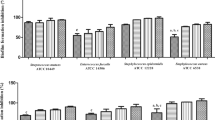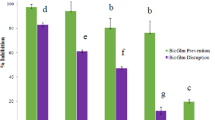Abstract
Diabetic foot ulcer caused by vancomycin-resistant Enterococcus strains is a troublesome concern that threatens public health. Due to the few treatment options, it is essential to develop a new alternative antibacterial agent with high efficacy. In the current study, we evaluated the antibacterial and antibiofilm properties of usnic acid (UA), a secondary metabolite of lichens. Microdilution broth and crystal violet methods were applied to determine the antibacterial and antibiofilm activities, respectively. To further elucidate the biofilm inhibition, scanning electron microscopy imaging was performed. In addition, the antioxidant activity of UA was investigated by 2, 2-diphenyl-1-picrylhydrazyl assay. The bacteriostatic and bactericidal activity of UA was observed as an amount of 23.02 and 312.5 μg/mL, respectively. UA suppressed biofilm formation and motivated the reduction of free oxygen radicals. The present study may open up a new perspective to combat biofilm-forming enterococci.




Similar content being viewed by others
References
Shahi SK, Kumar A (2016) Isolation and genetic analysis of multidrug resistant bacteria from diabetic foot ulcers. Front Microbiol 6:1464
Henig O, Pogue JM, Martin E et al (2020) The impact of multidrug-resistant organisms on outcomes in patients with diabetic foot infections. Open forum infectious diseases. Oxford University Press US, Oxford
Hashimoto Y, Taniguchi M, Uesaka K, Nomura T, Hirakawa H, Tanimoto K, Tamai K, Ruan G, Zheng B, Tomita H (2019) Novel multidrug-resistant enterococcal mobile linear plasmid pELF1 encoding vanA and vanM gene clusters from a Japanese vancomycin-resistant enterococci isolate. Front Microbiol 10:2568
Said MS, Tirthani E, Lesho E (2021) Enterococcus infections. StatPearls [Internet]
Esmaeili D, Daymad SF, Neshani A et al (2019) Alerting prevalence of MBLs producing Pseudomonas aeruginosa isolates. Gene Rep 16:100460
Kakoullis L, Papachristodoulou E, Chra P et al (2021) Mechanisms of antibiotic resistance in important gram-positive and gram-negative pathogens and novel antibiotic solutions. Antibiotics 10(4):415
Cui P, Feng L, Zhang L et al (2020) Antimicrobial resistance, virulence genes, and biofilm formation capacity among Enterococcus species from Yaks in Aba Tibetan autonomous prefecture, China. Front Microbiol 11:1250
Tan F, She P, Zhou L, Liu Y, Chen L, Luo Z, Wu Y (2019) Bactericidal and anti-biofilm activity of the retinoid compound CD437 against Enterococcus faecalis. Front Microbiol 10:2301
Pagano C, Ceccarini MR, Calarco P et al (2019) Bioadhesive polymeric films based on usnic acid for burn wound treatment: antibacterial and cytotoxicity studies. Coll Surf, B 178:488–499
Araújo A, De Melo M, Rabelo T et al (2015) Review of the biological properties and toxicity of usnic acid. Nat Prod Res 29(23):2167–2180
Araújo HDAd, Silva HAMF, Silva Júnior JGd et al (2021) The natural compound hydrophobic usnic acid and hydrophilic potassium usnate derivative: applications and comparisons. Molecules 26(19):5995
Cocchietto M, Skert N, Nimis P et al (2002) A review on usnic acid, an interesting natural compound. Naturwissenschaften 89(4):137–146
Grumezescu AM, Cotar AI, Andronescu E et al (2013) In vitro activity of the new water-dispersible Fe3O4@ usnic acid nanostructure against planktonic and sessile bacterial cells. J Nanopart Res 15(7):1–10
Francolini I, Norris P, Piozzi A et al (2004) Usnic acid, a natural antimicrobial agent able to inhibit bacterial biofilm formation on polymer surfaces. Antimicrob Agents Chemother 48(11):4360–4365
Nithyanand P, Beema Shafreen RM, Muthamil S et al (2015) Usnic acid, a lichen secondary metabolite inhibits Group A Streptococcus biofilms. Antonie Van Leeuwenhoek 107(1):263–272
Hoa NT, Van Bay M, Mechler A et al (2020) Is usnic acid a promising radical scavenger? ACS Omega 5(28):17715–17720
Murray PR, Rosenthal KS, Pfaller MA (2020) Medical microbiology. Elsevier Health Sciences, Netherlands
Rengaraj R, Mariappan S, Sekar U et al (2016) Detection of vancomycin resistance among Enterococcus faecalis and Staphylococcus aureus. J Clin Diagn Res: JCD. 10(2):DC04
Haghi F, Lohrasbi V, Zeighami H (2019) High incidence of virulence determinants, aminoglycoside and vancomycin resistance in enterococci isolated from hospitalized patients in northwest Iran. BMC Infect Dis 19(1):1–10
Humphries R, Bobenchik AM, Hindler JA et al (2021) Overview of changes to the clinical and laboratory standards institute performance standards for antimicrobial susceptibility testing, M100. J Clin Microbiol 59(12):e00213-e221
Haddad Kashani H, Fahimi H, Dasteh Goli Y et al (2017) A novel chimeric endolysin with antibacterial activity against methicillin-resistant Staphylococcus aureus. Front Cell Infect Microbiol 7:290
Kırmusaoğlu S. (2019) The methods for detection of biofilm and screening antibiofilm activity of agents. Antimicrobials, antibiotic resistance, antibiofilm strategies and activity methods. pp 1–17
Gómez-Sequeda N, Cáceres M, Stashenko EE et al (2020) Antimicrobial and antibiofilm activities of essential oils against Escherichia coli O157: H7 and methicillin-resistant staphylococcus aureus (MRSA). Antibiotics 9(11):730
Cakmak KC, Gülçin İ (2019) Anticholinergic and antioxidant activities of usnic acid-an activity-structure insight. Toxicol Rep 6:1273–1280
Senanayake SN (2013) Green tea extract: chemistry, antioxidant properties and food applications—a review. J Funct Foods 5(4):1529–1541
Hariri A, Ouis N, Bouhadi D et al (2020) In vitro antioxidant activity of essential oil of aerial parts of Mentha pulegium L. Acta Agric Serbica 25(50):193–197
de Torre MP, Cavero RY, Calvo MI et al (2019) A simple and a reliable method to quantify antioxidant activity in vivo. Antioxidants 8(5):142
Elo H, Matikainen J, Pelttari E (2007) Potent activity of the lichen antibiotic (+)-usnic acid against clinical isolates of vancomycin-resistant enterococci and methicillin-resistant Staphylococcus aureus. Naturwissenschaften 94(6):465–468
Ananthi R, Tinabaye A, Ganesan T et al (2016) Antimicrobial and anti-inflammatory activity of usnic acid and its acetyl derivative usnic acid diacetate. Int J Sci Eng Res 7(8):39–44
Paudel B, Bhattarai HD, Lee HK et al (2010) Antibacterial activities of Ramalin, usnic acid and its three derivatives isolated from the Antarctic lichen Ramalina terebrata. Zeitschrift für Naturforschung C 65(1–2):34–38
Kukla R, Mazurova J, Bostikova V et al (2014) In vitro antibacterial activity of usnic acid and octylgallate against resistant Enterococcus strains. Mil Med Sci Lett (Voj Zdrav Listy) 83:104–113
Luzina OA, Salakhutdinov NF (2018) Usnic acid and its derivatives for pharmaceutical use: a patent review (2000–2017). Expert Opin Ther Pat 28(6):477–491
Gupta V, Verma S, Gupta S et al (2012) Membrane-damaging potential of natural L-(−)-usnic acid in Staphylococcus aureus. Eur J Clin Microbiol Infect Dis 31(12):3375–3383
Zuo G-Y, Fu R-C, Yu W et al (2018) Potentiation effects by usnic acid in combination with antibiotics on clinical multi-drug resistant isolates of methicillin-resistant Staphylococcus aureus (MRSA). Med Chem Res 27(5):1443–1448
Lauinger IL, Vivas L, Perozzo R et al (2013) Potential of lichen secondary metabolites against Plasmodium liver stage parasites with FAS-II as the potential target. J Nat Prod 76(6):1064–1070
Pozzi P, Zanasi T, Taurino R (2012.) Method for making, by a sol-gel process, catheters including antibacteric coatings based on usnic acid. p WO2012123803
Behera BC, Mahadik N, Morey M (2012) Antioxidative and cardiovascular-protective activities of metabolite usnic acid and psoromic acid produced by lichen species Usnea complanata under submerged fermentation. Pharm Biol 50(8):968–979
Popovici V, Bucur L, Popescu A et al (2021) Antioxidant and cytotoxic activities of Usnea barbata (L.) FH Wigg. dry extracts in different solvents. Plants. 10(5):909
Moosavian M, Ghadri H, Samli Z (2018) Molecular detection of vanA and vanB genes among vancomycin-resistant enterococci in ICU-hospitalized patients in Ahvaz in southwest of Iran. Infect Drug Resist 11:2269
Tatsing Foka FE, Ateba CN (2019) Detection of virulence genes in multidrug resistant enterococci isolated from feedlots dairy and beef cattle: implications for human health and food safety. BioMed Res Int. https://doi.org/10.1155/2019/5921840
Acknowledgements
We would you like to thank our colleagues for their help in this study.
Funding
This study was financially supported by Vice-Chancellor of Research, Kashan University of Medical Sciences, Kashan, Iran [Grant Number: 97128].
Author information
Authors and Affiliations
Corresponding author
Ethics declarations
Conflict of interest
None declared.
Additional information
Publisher's Note
Springer Nature remains neutral with regard to jurisdictional claims in published maps and institutional affiliations.
Supplementary Information
Below is the link to the electronic supplementary material.
Rights and permissions
Springer Nature or its licensor (e.g. a society or other partner) holds exclusive rights to this article under a publishing agreement with the author(s) or other rightsholder(s); author self-archiving of the accepted manuscript version of this article is solely governed by the terms of such publishing agreement and applicable law.
About this article
Cite this article
Marzhoseyni, Z., Rashki, S. & Khaledi, A. Antibacterial, antibiofilm, and antioxidant impacts of usnic acid against vancomycin-resistant enterococcus. Polym. Bull. (2024). https://doi.org/10.1007/s00289-024-05206-z
Received:
Revised:
Accepted:
Published:
DOI: https://doi.org/10.1007/s00289-024-05206-z




